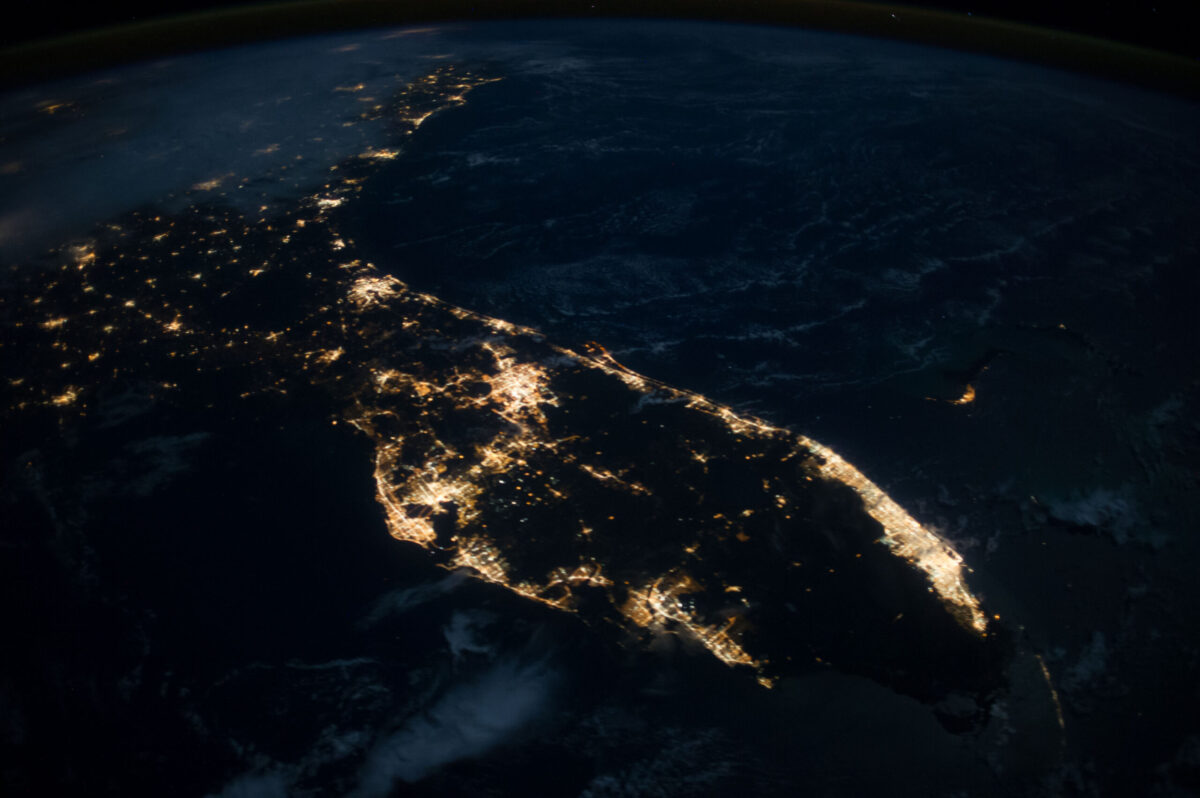
Summer Stargazing in Big Cypress
Summer is here! The first day of summer was only a few days ago, on June 21st. In South Florida, this means clear, balmy nights after days packed full of fun in the sun. Did you know that summer is a great time to stargaze? While most people see the winter months as the best for stargazing, summer holds its own star-studded allure. This week, we encourage you to look up! Follow along for summer stargazing tips, celestial events, and where to stargaze in the Everglades.
Dark Skies
When considering ideal conditions for summer stargazing, dark skies are a must! Dark skies are actually an important natural resource. They are called natural lightscapes and encompass “resources and values that exist in the absence of human-caused light at night.” Human-caused light pollution threatens these natural lightscapes. Light pollution makes star-gazing difficult. Unfortunately, it can also threaten entire ecosystems. Many animals rely on the natural rhythms of light and dark to orient themselves, hide from predators, or cue behaviors. Some animals are also light sensitive. Before human development “hatchling turtles were guided to the ocean by an instinct to travel away from the dark silhouettes of dune vegetation and toward…the light from the sky reflecting off the ocean.” Now, artificial lights unfortunately attract wayward sea turtle hatchlings and leads them astray. Protecting natural lightscapes is important for the health of the ecosystem, as well as for ideal stargazing.
In the featured photo above, you can see how bright the lights are in major metropolitan areas in Florida. Courtesy of the Earth Science and Remote Sensing Unit, NASA Johnson Space Center, it shows the Florida Peninsula at night. East is Fort Lauderdale and Miami, and to the west is Fort Myers and Naples. The center lies dormant and dark compared to those bright coasts! There is where you will find the best conditions for summer stargazing. Away from the light pollution found in those metropolitan areas, you can see stars, planets, and galaxies. In places like Everglades National Park, you can even see the Milky Way on clear nights. The Milky Way is the galaxy that holds our solar system. Around the time of the new moon, when conditions are dark, you should spot this sweeping band of stars and dust.
2022’s Supermoon Season
Did you see the full moon rise last week? A “Strawberry Supermoon” was visible on June 14th. According to the Farmer’s Almanac, Strawberry Moon refers to the June ripening of strawberries ready to be picked. This Strawberry Moon was also a supermoon, appearing brighter and larger to people observing. A supermoon is when a “full moon coincides with the Moon’s closest approach to Earth in its elliptical orbit, a point known as perigee.” So, this means the day the moon is at its closest point relative to Earth overlaps with it being full. Since the moon is closer, it also causes higher tides. Generally, any full moon that occurs within 90% of that closest point is considered a supermoon. They only happen three or four times a year, as these two conditions do not overlap often. They appear about 17% bigger and 30% brighter than normal full moons.
Supermoons also appear consecutively. The Strawberry Supermoon that happened on June 14th is only the second of four supermoons that will rise this summer. The next will be on July 13th, and is a “Buck Moon.” Buck Moon refers to new antler growth seen on male deer during this time. Moon names, like Strawberry Moon or Buck Moon, are usually rooted in traditional knowledge. They were used to identify and track the seasons. On August 11th, the full “Sturgeon Moon” will be the final supermoon of the year.
Supermoons are a great lunar event to observe for beginners. With the help of telescopes and binoculars, amateur observers can see these bigger moons better. Craters, mountains, and other features on the moon’s surface are visible in more detail. But, don’t worry if you don’t have a telescope! You should be able to observe these supermoons well with the naked eye.

Preschool children stargazing – Tallahassee, Florida. 1960 (circa). State Archives of Florida, Florida Memory.
Stargazing in the Everglades
South Florida is a fast-paced place, with bustling beach cities to tempt any traveler. But, if you’re trying to stargaze, these metropolitan areas are not your best bet. To see the summer stars the best, you will need to venture away from the coasts. Below are three great spots you can see stars this summer.
Big Cypress Seminole Indian Reservation
The biggest of the Seminole Tribe of Florida’s reservations, the Big Cypress Indian Reservation is a great place to star or sun-gaze. Removed from the bustle of Fort Lauderdale and Fort Myers, it is north of the Big Cypress National Preserve and the Everglades National Park. Stay overnight at the Big Cypress RV Resort, and watch the sky come alive in the Everglades! The Resort has paved RV spots for rent (full hook-ups), as well as ample recreational opportunities. During the day, wander over to the Ah-Tah-Thi-Ki Museum to learn more about Seminole history, culture, and art. Learn more about what the Big Cypress Indian Reservation has to offer here and here in previous blog posts.
Big Cypress National Preserve
With eight campgrounds, the Big Cypress National Preserve is a great place to camp and star gaze. Just south of the Big Cypress Seminole Indian Reservation and along Tamiami Trail, Big Cypress National Preserve spans 729,000 acres of swampland. In the winter, astronomy programs run through the Preserve. Learn more about Big Cypress National Preserve, as well as Seminole and Miccosukee customary use rights within it, here in a previous blog post.
Everglades National Park
Extending to the southernmost tip of the Florida Peninsula, Everglades National Park is the third super-star location for ideal nighttime viewing on our list. Protecting the unique ecosystem of the Florida Everglades, it is a must-see National Park for any traveler. There are several campgrounds perfect for an overnight stargazing trip. Beyond stargazing, there are numerous ranger-led programs, hiking and biking trails, boat launches, and more!
New to stargazing? Here are some tips for getting started:
Outfit your packing list
You don’t need any specialized equipment to stargaze, but adding a few things to your packing list will make your experience much more enjoyable. Think carefully about what you may want to bring! Binoculars or a telescope can make spotting things like meteors or constellations easier. Bug spray is a must for South Florida nighttime. The evenings also cool significantly, so pack a jacket or warm blanket. If you are traveling to different spots, fill up your gas tank and be sure to keep comfortable shoes, rain gear, and a flashlight on hand. If you want to be a star photographer, a DSLR with wide angle lens is enough to take some stunning night sky photos.
Check the weather and conditions
There is nothing worse than the weather ruining grand plans for a great evening. Before trekking out, check weather conditions and the cloud cover. You won’t see any stars if there are clouds covering the night sky! Check out this Night Sky Planner hosted by NASA to make the most of your evening. There are Sky Maps, a Clear Sky Chart, as well as moonrise and sunset times. With these, you will be able to make sure you have the right conditions for seeing stars.
Be safe
Above, we talked a bit about light pollution and how it impacts stargazing. Generally, the best place to see stars is far away from well populated areas. Since you need to be away from major cities for the best star views, it is important to consider safety concerns. Always bring a star gazing buddy along with you. Pack extra chargers, emergency items, and snacks. Make sure to download offline maps in case you lose service, so you don’t get lost. A backup paper map, as well as training on how to use it, is also great to have on hand. Be aware and respectful of animals you may see, and how to best interact with them.
Celestial Events this Summer
In addition to the regular beauty of star constellations, there are several special celestial events happening this summer to check out! Look below for a list of the exciting things you can spot while stargazing this summer and into fall.
Late June – Five Planets Line up with the moon. Mercury, Venus, Mars, Jupiter, and Saturn will line up in the night sky along with the moon.
July 13th – Full Buck Moon (Supermoon)
July 28-29th – the Southern Delta Aquariid Meteor Shower. Although it lasts a little over a month, the shower will peak around July 29th.
August 11th – Full Sturgeon Moon (Supermoon)
August 11th-13th – Perseid Meteor Shower. Although unfortunately competing with the Full Sturgeon Moon’s light, the meteor shower should still be viewable.
November 8th – Total Lunar Eclipse
So, are you ready to break out the binoculars and settle in for a night of summer stargazing? From supermoons to stars, the night sky is sure to dazzle. If you’re star gazing in a nature area, consider your impact and actions, and be an ethical visitor. Seek opportunities to protect these natural lightscapes, so future generations can see those same stars!



